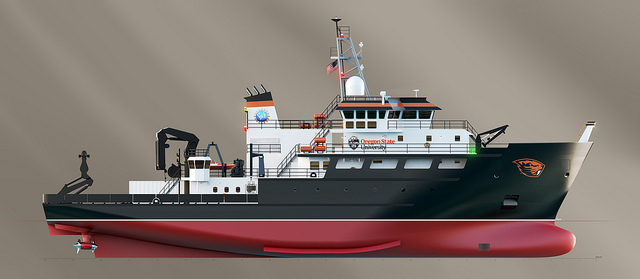Gulf Island Shipyards, Houma, La., has received a contract to build a second 193'x41' regional class research vessel (RCRV) for Oregon State University (OSU). Seattle-based Glosten designed the vessels.
The first vessel was awarded in July 2017, which included options for two additional vessels. The state-of-the-art ships are designed to be highly flexible, multimission platforms that maximize energy efficient design concepts, the announcement said. The vessels will be built in Houma and be ABS Ice-Class C0 and DPS-1, Green Marine-certified, acoustically quiet, and carry up to 29 crew and scientists per vessel. The National Science Foundation (NSF) is providing $88 million for the project.
The second research vessel is the second of three planned for the Pacific, Atlantic and Gulf of Mexico coasts. NSF chose OSU in 2013 to be the lead institution on the project for planning and selecting a shipyard. The building program calls for the first OSU vessel to be delivered in 2020, followed by a yearlong testing program.The first research vessel will focus on missions in West Coast and Alaska waters when its research voyages start in fall 2021. The follow-on vessels would be delivered in 2021 and 2022.
The ships are a long sought after addition to the U.S. academic research fleet. They will be accepted after their first year of testing and certification by the University-National Oceanographic Laboratory System (UNOLS), which coordinates operations of research ships owned by the NSF, Navy and other institutions.
The next-generation class will include capabilities for detailed seafloor mapping to help understand geologic structures and processes such as the Cascadia subduction zone, which puts the Northwest at high risk for earthquakes and tsunamis, OSU officials said.
With a cruising speed of 11.5 knots and a 7,000-mile range, the RCRVs will have at least 21 days endurance at sea, with 16 berths for researchers and 13 for crew.
The design also has numerous “green” features for energy efficiency and lower emissions, including an optimized hull form, waste heat recovery, LED lighting, and variable speed power generation.”
OSU previously operated the 184' research vessel Wecoma from 1975 until its retirement in 2012, and then took over operation of a sistership, the Oceanus, that had been based at the Woods Hole Oceanographic Institution in Massachusetts. The Oceanus will in turn be retired when the first new RCRV becomes fully operational in 2021.
“We are very pleased that OSU has exercised their first option for the second RCRV,” Kirk Meche, president and CEO of Gulf Island, said in a prepared statement announcing the contract for the second vessel. “Our shipyard team and the OSU team have been working very closely since the first vessel contract award back in July of last year, and we look forward to continuing these efforts with the second vessel. Our shipyard has now been successful in adding over $350 million in new orders to their backlog since early last year with awards coming from commercial transportation, government research and transportation, and the defense industry including the U.S. Navy among other markets.”
"OSU has enjoyed working with Gulf Island Shipyards over the last several months on the first vessel and we are excited to move forward with the second vessel,” Dr. Roberta Marinelli, dean of OSU's College of Earth, Ocean, and Atmospheric Sciences, said. “We are also looking forward to delivering the nation's newest class of oceanographic research ships to the National Science Foundation and the ocean science community. Gulf Island's reputation for quality work and customer service are a perfect fit for this important project."





